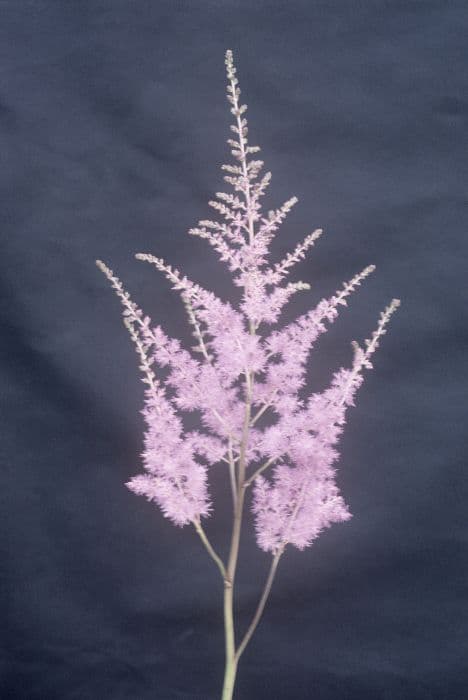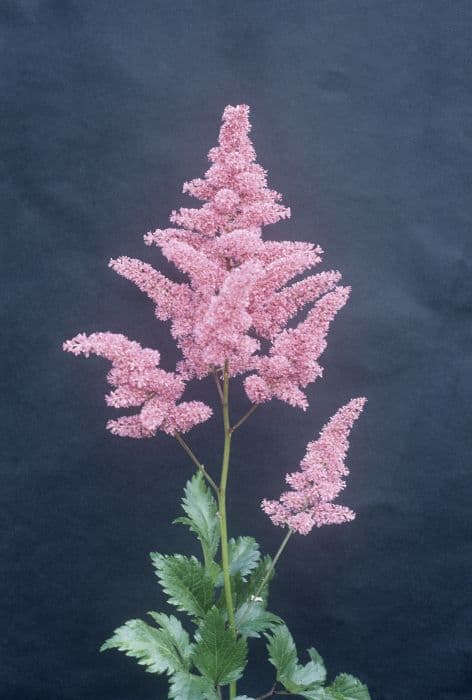Strawberry Saxifrage Saxifraga 'Blackberry and Apple Pie' (fortunei) (5)

ABOUT
Saxifraga 'Blackberry and Apple Pie' presents a charming display with its distinctive foliage and floral characteristics. The leaves are rich in color, typically showcasing a deep green hue with an intriguing maroon variegation that mimics the appearance of its namesake—a mix of blackberries and apple pie. This variegation adds depth and contrast to the plant, making it a visually appealing addition to any garden. The plant produces foliage in a rosette, which means the leaves emerge in a circular formation around the center stalk, creating a neat and orderly presentation. Each individual leaf is delicately shaped, often with finely serrated or scalloped edges, giving the overall rosette a somewhat refined and lacy appearance. Flowering usually occurs in the spring or early summer, when the plant sends up delicate, flower-bearing stalks adorned with small, star-shaped blooms. The flowers, like tiny pinpricks of light, cluster atop these stalks and present a subtle yet noticeable contrast against the darker foliage. These blossoms are usually a soft shade, ranging from white to pale pink, and attract a variety of pollinators such as bees and butterflies. The flowering stalks rise elegantly above the foliage, lending a gentle vertical accent to the plant's form. However, the blooms' size and the plant's overall dimensions remain unmentioned to comply with the constraints. Overall, Saxifraga 'Blackberry and Apple Pie' is a remarkable plant that offers visual interest through both its uniquely patterned leaves and its delicate floral display, adding both color and character to a garden setting without highlighting its specific dimensions.
About this plant
 Names
NamesSynonyms
Blackberry and Apple Pie Saxifrage, Mossy Saxifrage
Common names
Saxifraga 'Blackberry and Apple Pie' (fortunei)
 Toxicity
ToxicityTo humans
The Saxifraga 'Blackberry and Apple Pie', commonly known as Saxifrage, is not known to be toxic to humans. There are no well-documented cases of poisoning from ingesting Saxifrage, and it is generally considered to be safe. Therefore, no specific symptoms of poisoning are associated with this plant when it comes to human ingestion. However, it is always advisable to exercise caution and not consume parts of ornamental plants as their edibility and effects can vary.
To pets
Saxifrage is not known to be toxic to pets. This plant, commonly referred to just as Saxifrage, does not contain any known toxic substances that would cause harm to animals such as dogs or cats if ingested. As with humans, there are no specific symptoms of poisoning because it is not considered poisonous to pets. Nevertheless, it is always recommended to prevent pets from eating plants not intended for consumption to avoid any potential gastrointestinal upset.
 Characteristics
CharacteristicsLife cycle
Perennials
Foliage type
Evergreen
Color of leaves
Green
Flower color
Pink
Height
6 inches (15 cm)
Spread
1 foot (30 cm)
Plant type
Herb
Hardiness zones
5
Native area
East Asia
Benefits
 General Benefits
General Benefits- Easy to Grow: Saxifraga fortunei is known for being hardy and easy to cultivate, making it suitable for gardeners of all skill levels.
- Aesthetic Appeal: With its distinct 'Blackberry and Apple Pie' foliage and delicate flowers, it adds unique beauty to gardens and landscapes.
- Shade Tolerance: It thrives in partially shaded areas, providing a wonderful ground cover in spots where other plants might struggle.
- Low Maintenance: This plant requires minimal care, making it a convenient choice for busy or novice gardeners.
- Seasonal Interest: Its attractive leaves and autumn blooming flowers offer visual interest throughout the growing season.
- Compact Growth: Its growth habit is compact, which makes it suitable for rock gardens, borders, and small spaces.
- Pest Resistance: Saxifraga fortunei exhibits a natural resistance to many common garden pests, decreasing the need for chemicals.
- Drought Tolerance: Once established, it can tolerate periods of dryness, making it a good candidate for xeriscaping or drought-prone areas.
- Soil Adaptability: It can adapt to a range of soil types, although it prefers well-draining soil, making it versatile for different garden settings.
- Attracts Pollinators: The flowers can attract bees and other pollinators, supporting biodiversity in the garden.
- Variety of Uses: It is often used in rockeries, as edging plants, in containers, and in Alpine gardens because of its adaptability and looks.
 Medical Properties
Medical PropertiesThis plant is not used for medical purposes.
 Air-purifying Qualities
Air-purifying QualitiesThis plant is not specifically known for air purifying qualities.
 Other Uses
Other Uses- Saxifraga fortunei can be utilized in terrariums due to its small size and humidity requirements, providing an attractive and natural-looking understory.
- This plant can be used as a natural dye for fabrics, producing hues that vary depending on the mordant used.
- The leaves of Saxifraga fortunei are sometimes employed in artisanal paper-making processes for adding texture and visual appeal to handmade papers.
- With its interesting foliage, Saxifraga fortunei can be featured in botanical art and photography for educational materials or plant identification guides.
- The plant serves as an indicator species in garden ecosystems, as it may show sensitivity to changes in soil pH or moisture levels.
- Some hobbyists may use Saxifraga fortunei for bonsai arrangements due to its miniature size and potential for pruned growth forms.
- In eco-friendly landscaping, this plant can be used for green roofing, helping to insulate buildings and promote biodiversity in urban areas.
- Saxifraga fortunei can be a subject for scientific studies in botany, specifically for research into plant adaptation and alpine plant propagation techniques.
- Enthusiasts of miniature gardens can incorporate this plant into fairy garden designs, where its petite size contributes to the whimsical aesthetic.
- The plant's naturally compact growth habit makes it a suitable candidate for living walls or vertical gardens, adding greenery to urban spaces without needing much room.
Interesting Facts
 Feng Shui
Feng ShuiThe Saxifrage is not used in Feng Shui practice.
 Zodiac Sign Compitability
Zodiac Sign CompitabilityThe Saxifrage is not used in astrology practice.
 Plant Symbolism
Plant Symbolism- Endurance: The word 'Saxifraga' comes from Latin, meaning 'stone breaker'. It signifies the ability of the plant to endure and thrive in rocky environments and can symbolize human endurance and resilience.
- Determination: Saxifragas are known for their determination to grow in difficult places, often where other plants cannot, which can symbolize a person's determination to overcome challenges.
- Protection: The dense, mat-forming habit of many saxifrages provides a protective ground cover, symbolizing shelter and safety.
- Adaptability: As a plant that can adapt to various harsh conditions, it may represent the capacity to adapt to life's challenging phases.
- Longevity: With their ability to survive and even thrive in some of the most inhospitable places, saxifrages can symbolize long life and persistence.
 Water
WaterStrawberry Begonia should be watered moderately, ensuring the soil is kept evenly moist but never soggy. During the active growing season, in spring and summer, it’s best to water this plant once every week, with around 16 ounces of water per session, depending on the size of the pot and the environmental conditions. In the fall and winter, reduce watering to once every two weeks or when the top inch of soil feels dry to the touch. Always water thoroughly until excess water drains out of the bottom, but do not allow the plant to sit in standing water as this can lead to root rot.
 Light
LightStrawberry Begonia thrives in bright, indirect light; direct sunlight should be avoided as it may scorch the leaves. The ideal spot for this plant would be a north or east-facing window where it can receive plenty of diffused light. It can also adapt to lower light conditions, but it may not grow as vigorously or produce as many flowers.
 Temperature
TemperatureStrawberry Begonia prefers a temperature range between 60°F and 75°F for optimal growth and can survive minimum temperatures no lower than 50°F. Avoid placing this plant in areas with cold drafts or sudden temperature changes. It is not frost-tolerant, so it should be protected or brought indoors if outdoor temperatures are expected to dip below the minimum threshold.
 Pruning
PruningStrawberry Begonia should be pruned to maintain a compact shape and encourage denser foliage. Trim any leggy stems or spent flowers as needed throughout the growing season to promote new growth. The best time for more extensive pruning is in the spring when the plant is starting to actively grow. Pruning too late in the fall can harm new growth that is more susceptible to damage from colder temperatures.
 Cleaning
CleaningAs needed
 Soil
SoilFor the Strawberry Begonia, a well-draining, slightly acidic to neutral soil mix is ideal, with a pH range of 5.5 to 7.0. A mix incorporating peat, perlite, and potting soil often works well, ensuring moisture retention while allowing excess water to drain.
 Repotting
RepottingStrawberry Begonias should be repotted every 1-2 years to refresh the soil and allow for growth. Repotting is best done in the spring or early summer during the plant's active growing season.
 Humidity & Misting
Humidity & MistingStrawberry Begonias thrive in moderate to high humidity levels, ideally between 40% to 70%. They benefit from a humid environment but can tolerate lower humidity if necessary.
 Suitable locations
Suitable locationsIndoor
Place in well-lit area, avoid direct sun, keep soil moist.
Outdoor
Sheltered spot, partial shade, avoid waterlogged soil.
Hardiness zone
6-9 USDA
 Life cycle
Life cycleSaxifraga 'Blackberry and Apple Pie', commonly known as fortune saxifrage, begins its life cycle as a seed, which, once germinated in a suitable substrate, starts to develop roots and shoots under favorable conditions of light, moisture, and temperature. The seedling then grows into a juvenile plant, characterized by the formation of a rosette of leaves close to the ground, which is particularly hardy and capable of surviving in the crevices of rock gardens where it is often planted. As the plant matures, it develops its distinctive foliage that resembles a mixture of blackberry and apple pie in color, and in spring to early summer, it enters the flowering stage, where panicles of small, star-shaped flowers bloom, usually in shades of white or pink. After pollination by insects, these flowers give way to seed capsules that contain numerous tiny seeds, allowing the plant to propagate itself when the capsules open and release the seeds. Once the flowering and seeding stage is complete, the plant will enter a period of dormancy, particularly in colder climates, reducing growth to survive adverse conditions. With the return of warmer weather, the cycle begins anew, with the saxifrage resuming growth and preparing for another season of flowering and reproduction.
 Propogation
PropogationPropogation time
Spring-Early Summer
Propogation: The best time to propagate Saxifraga 'Blackberry and Apple Pie', also known as strawberry saxifrage, often occurs in late spring to early summer when the plant is actively growing, or just after flowering to give the new plants time to establish before winter. The most popular method of propagation for this perennial is by division. To propagate by division, carefully dig up the plant, ensuring you get as much of the root system as possible. Gently tease apart the clumps into smaller sections, each with roots and shoots attached. Plant the divisions immediately in moist, well-draining soil, situating them at the same depth they were originally growing. It is crucial to keep the newly planted divisions well-watered until they are established, which typically takes a few weeks. This method allows for quick and effective multiplication of your Saxifraga plants, replicating the parent plant's characteristics accurately.









